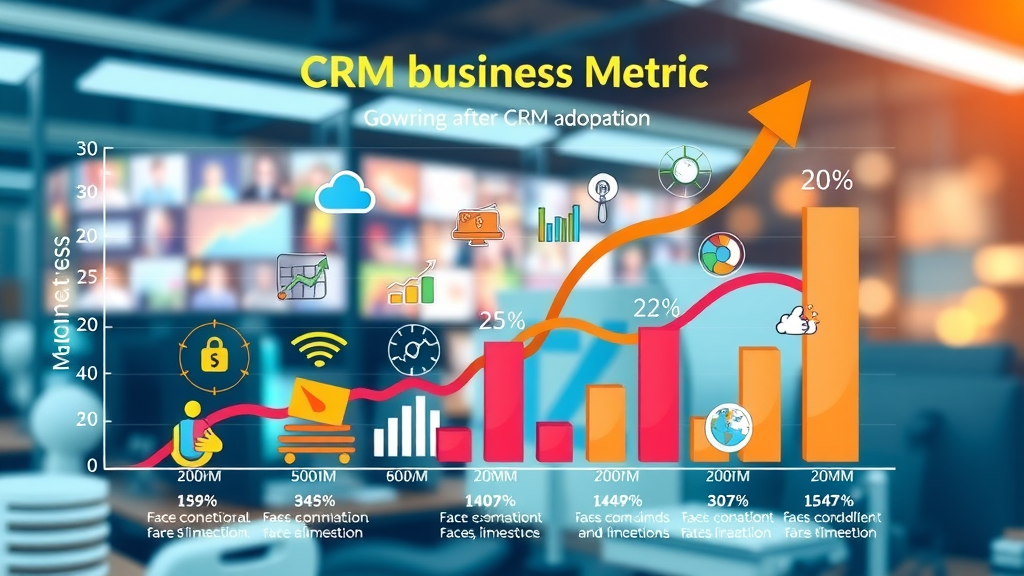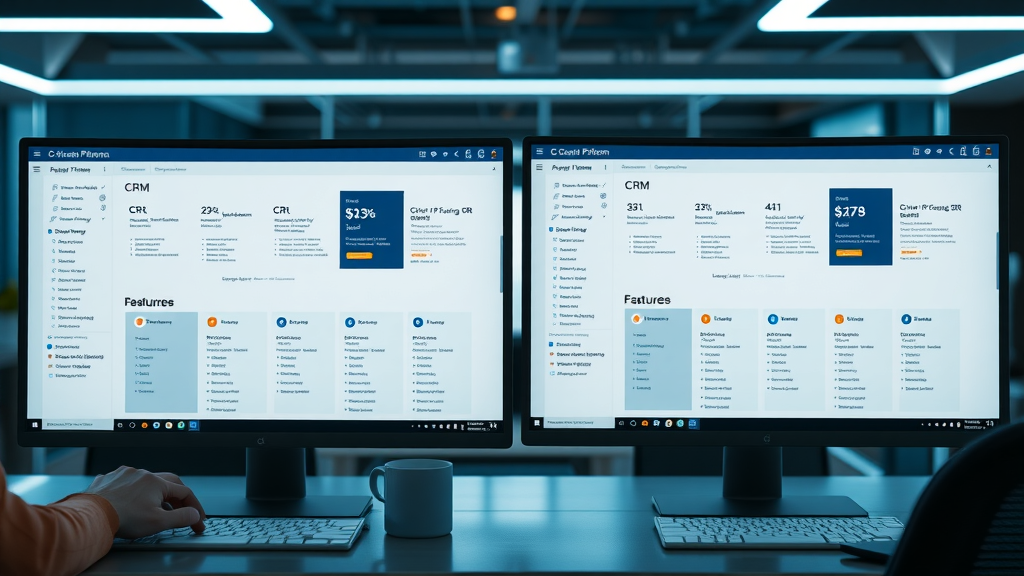"Companies that leverage CRM software can increase sales by up to 29%, improve productivity by 34%, and enhance forecast accuracy by 42%." – Salesforce Research
Imagine growing your business by nearly one-third just by adopting the right technology. CRM software benefits go far beyond tracking customer details—they modernize your business, fuel productivity, and help teams deliver unparalleled customer service. Within this educational guide, you'll learn how the right CRM software can unlock new growth, increase efficiency, and build customer loyalty that lasts.
Understanding CRM Software Benefits: The Backbone of Business Growth

- How harnessing crm software benefits directly impacts revenue and operational efficiency
- Key advantages over traditional relationship management methods
At its core, CRM software transforms how companies connect with their customers. Unlike outdated spreadsheets or a patchwork of notes, modern CRM systems create a single, integrated platform for managing every aspect of the customer relationship . This centralization means that valuable customer data is always accurate, up-to-date, and accessible to everyone who needs it—from sales teams to customer support and the marketing team. By using a CRM platform, organizations foster stronger customer relations , enabling better personal service while streamlining operations.
The immediate impacts are clear: teams work more efficiently, duplicate tasks are eliminated, and communication flows freely. Over time, CRM software benefits compound, leading to increased sales, better forecasting, and improved customer satisfaction. With robust relationship management tools, businesses can finally move away from reactive operations toward a proactive, data-driven strategy that's built for scalability and growth. In today's fast-paced market, investing in CRM solutions isn't just about keeping up—it's about pulling ahead.
Why CRM System Implementation Transforms Customer Relations
Exploring CRM Systems: Tools for Stronger Customer Relationships

To truly understand the power of CRM software benefits, consider daily customer interactions. A crm system equips sales and support teams with detailed histories, preferences, and communications—all in one place. This deep customer insight lets teams tailor each interaction, predict needs, and make customers feel uniquely valued. Unlike basic crm tools or manual processes, a modern crm platform facilitates multi-channel communication (email, chat, phone, and even social media), ensuring every touchpoint is logged, analyzed, and acted upon.
For growing businesses, a robust CRM solution means there’s no more scrambling for details or missing key follow-ups. By using a CRM system for customer relationship management, teams collaborate more effectively, sharing context and leveraging past interactions to provide fast, personalized support. The result? Increased sales conversion rates, shorter sales cycles, and higher retention. In short, CRM software helps transform good customer service into exceptional customer relationships.
As the customer journey becomes more complex, CRM systems provide the backbone for consistent, reliable, and meaningful connections. Customers appreciate organizations that remember their preferences, anticipate their needs, and resolve issues before they escalate. With a quality CRM platform, these best-in-class experiences become the norm, leading to measurable boosts in loyalty and word-of-mouth referrals.
Relationship Management: Building Trust and Loyalty with CRM Software Benefits
Relationship management goes beyond simply maintaining a contact list—it's about building trust, loyalty, and genuine connections. CRM software empowers businesses to track every interaction and milestone along the customer lifecycle, putting context at the fingertips of any team member. This means marketing teams can launch targeted campaigns based on real-time customer interests, while sales teams follow up with relevant, timely offers that resonate.
Over time, the insights gathered by CRM software paint a vivid picture of your customer base. Patterns in behavior, purchasing cycles, and support preferences emerge, enabling proactive outreach and problem resolution. This level of personalization not only improves satisfaction but also drives upselling and cross-selling opportunities. Trust is built each time a business remembers a birthday, addresses a concern swiftly, or provides relevant advice—all powered by accessible, well-organized customer information .
Ultimately, the crm software benefits in relationship management extend far beyond immediate sales. By nurturing long-term relationships, brands create advocates who return for repeat business and recommend the company to others, supporting sustainable growth through trust and loyalty.
How CRM Software Streamlines the Sales Process and Marketing Team Collaboration
CRM Platform Features Supporting Sales Teams Across the Sales Pipeline
CRM systems shine where it matters most: the challenging, often-fragmented sales process . By mapping every step of the journey inside a CRM platform, sales teams gain critical visibility throughout the sales pipeline. Automation features remind reps of key follow-ups, flag stalled deals, and provide the insights needed to prioritize high-value leads. No more missed opportunities—each stage is recorded, tracked, and optimized for success.
The ability for sales teams to collaborate in real time also leads to shorter sales cycles and higher closing rates. When one team member updates customer details or sales data, the whole crew benefits instantly. Integrated tools—like document sharing, lead scoring, scheduled reminders, and pipeline dashboards—ensure everyone is working from the same playbook. Whether it’s an initial inquiry or a contract negotiation, CRM software empowers sales teams to stay on target and execute effectively.
The crm system also enables sales managers to monitor progress, allocate resources, and identify coaching opportunities. The result? Teams that are consistently trained, supported, and focused on the most promising prospects, making sales outcomes more predictable and scalable.
CRM Solution Integration: Aligning Sales and Marketing Efforts for Measurable Results
Successful businesses know that sales and marketing must work together seamlessly—yet traditionally, these departments often operate in silos. Integrating a modern crm solution creates a unified view of campaigns, leads, and customer feedback. Marketing teams can pass qualified leads to sales at the perfect moment, while sales teams provide feedback on lead quality and closed deals, creating a feedback loop that improves targeting and messaging.
Workflow automation tools keep both teams accountable, sending reminders to the right people at the right time. Marketing gains direct visibility into campaign ROI as the CRM tracks which activities result in sales, helping optimize efforts and allocate budget. Likewise, real-time sales pipeline insights help set realistic expectations for future sales and inform campaign adjustments on the fly.
Integrating crm platforms with analytics tools, social media, and other sales technologies enhances collaboration, powered by enriched customer data . The result? Measurable improvements in conversion rates, deal sizes, and customer retention—all thanks to smarter, more collaborative workflow management.
| CRM System | Sales Features | Marketing Features | Customer Service |
|---|---|---|---|
| Salesforce | Lead scoring, pipeline tracking, automation | Personalized campaigns, ROI analytics | Omnichannel support, case management |
| HubSpot CRM | Deal pipeline, sales automation, alerts | Email marketing, landing pages, automation | Ticketing, live chat, self-service options |
| Zoho CRM | Email insights, AI predictions, workflow rules | Social media integration, automation | Multi-channel reporting, feedback tracking |
| Microsoft Dynamics 365 | Forecasting, advanced reporting, collaboration | Campaign orchestration, segmentation | Knowledge base, chatbot, SLA tracking |
| Pipedrive | Deal tracking, custom stages, reminders | Basic email marketing, integrations | Integrated helpdesk, notes, call tracking |
Enhancing Customer Experience and Service with CRM Software Benefits
Customer Service Excellence: Using CRM Systems to Exceed Expectations

Today’s customers expect personalized support and fast resolutions. A crm system ensures every customer query is answered with context—past purchases, open cases, and service history—empowering agents to resolve issues quickly and proactively. By exceeding customer expectations, businesses set themselves apart in crowded markets and foster lasting brand loyalty.
CRM helps track customer satisfaction metrics and feedback, allowing companies to improve their services continuously. Automated case management routes inquiries to the right customer support team member, ensuring no ticket gets overlooked or delayed. This seamless service delivery, powered by a crm platform , translates to happier customers and fewer negative reviews.
With integrated knowledge bases, live chat, and even AI-driven self-service options, crm software benefits extend to every interaction, keeping customers engaged and informed at every stage of their journey.
Data-Driven Insights: Personalizing the Customer Experience with CRM Platforms
A key advantage of CRM solutions lies in their ability to analyze vast amounts of customer data . Every interaction—emails, purchases, support tickets, and even social media activity—feeds into a central database. With this knowledge, businesses can deliver tailored promotions, recommend new products, or provide proactive support based on individual preferences.
CRM platforms turn raw data into actionable insights, driving intelligent decision-making at every touchpoint. Automated segmentation helps marketing teams create impactful, targeted campaigns that resonate with specific customer groups. Meanwhile, sales teams can identify upsell opportunities and develop approaches tailored to each prospect’s needs and history.
This data-driven approach enhances the customer experience and allows organizations to anticipate trends, measure engagement, and iterate faster than ever before. Whether you’re a small business or a growing enterprise, the ability to personalize at scale is a powerful differentiator enabled only by leveraging modern CRM platforms.
Essential CRM Software Benefits for Relationship Management

- Centralized customer data for better relationship management
- Enhanced productivity through automation
- Improved team collaboration and workflow efficiency
Relationship management is at the heart of every successful business. By assembling all relevant customer data—from contact details and purchase history to touchpoint tracking and sentiment analysis—a CRM tool ensures everyone in your organization is equipped to respond knowledgeably and quickly. This single source of truth reduces miscommunication, prevents lost information, and enables a seamless handoff between departments.
Operational workflows are further streamlined thanks to automation. Tasks like scheduling follow-ups, sending reminders, and updating records happen without manual intervention, freeing up time for high-value activities. Collaboration thrives as team members are easily able to share notes, assign tasks, and communicate within the CRM ecosystem.
The true CRM software benefits come into focus as customer satisfaction rises, response times drop, and your brand reputation grows. In a competitive marketplace, mastering effective relationship management with the aid of modern CRM software is a critical differentiator.
"A robust CRM system elevates the customer relationship to a strategic asset." – HubSpot CRM Analyst
Witness the transformation of customer relations in action: a national retailer adopted a modern CRM platform, integrating sales, marketing, and service teams onto a single dashboard. This move enabled them to tailor offers, coordinate support, and gain a 360-degree view of each customer. As a result, they significantly improved customer loyalty and saw measurable gains in both sales and operational efficiency.
In the video, you’ll see real-world examples of sales pipeline management, data analytics, and workflow automation that delivered results within months of CRM implementation. The case illustrates that CRM software benefits are not theoretical—they deliver tangible, scalable outcomes for organizations of every size.
Discover how investing in CRM systems can help your team turn customer relationships into a true driver of business growth and brand differentiation, setting the stage for long-term success.
Top CRM Platform Recommendations to Maximize CRM Software Benefits
- Salesforce
- HubSpot CRM
- Zoho CRM
- Microsoft Dynamics 365
- Pipedrive
Choosing the right crm system is crucial for realizing CRM software benefits. Salesforce stands out for customizable automation and deep analytics, while HubSpot CRM offers intuitive free tools and easy integration for growing teams. Zoho CRM shines with AI-powered insights and multi-channel communication, Microsoft Dynamics 365 seamlessly connects with popular office tools and enables global scalability, and Pipedrive is beloved for its visual sales pipeline and simplicity. Evaluate these top CRM platforms according to your business size, technical expertise, and industry needs for the best results.
Each platform supports core CRM software benefits such as relationship management, automation, collaboration, and actionable insights—enabling your team to manage customer interactions at every stage of the customer journey.
In-depth demos, free trials, and community feedback are invaluable when selecting your crm solution . Investing the time to choose wisely ensures maximum ROI and sets your organization up for future sales success.
Frequently Overlooked CRM System Features That Deliver Major CRM Software Benefits
- Advanced analytics and reporting
- Workflow automation tools
- Integrated multi-channel communication
- AI-powered recommendations

While most businesses focus on tracking customer contacts and sales pipelines, truly maximizing crm software benefits means exploring advanced, often underused features. Advanced analytics and reporting provide deep insights into sales performance, customer engagement, and marketing effectiveness, allowing organizations to optimize strategies in real time.
Integrated workflow automation streamlines repetitive tasks across departments, minimizes human error, and increases productivity. Multi-channel communication integrates emails, calls, chats, and more into a single interface, ensuring no customer message is overlooked. And, thanks to advances in AI, modern CRM platforms can recommend next-best actions, prioritize leads, and even predict customer churn.
By leveraging these features, businesses are equipped to respond quickly to trends, scale efficiently, and deliver proactive service, increasing retention and loyalty. Staying ahead of the competition starts with making the most of your CRM solution’s full capabilities.
Overcoming Common CRM Software Implementation Challenges
Change Management and User Adoption in CRM Systems

One of the biggest hurdles in realizing CRM software benefits lies in effective implementation—change management is critical. Staff must be trained on the new crm system , motivated to adopt new processes, and consistently encouraged to use the CRM platform as their single source of customer information. Involving team members early, clearly communicating the benefits, and showing how CRM helps in their daily work dramatically improves buy-in.
Executive sponsorship, gamification of onboarding, and the identification of internal "CRM champions" further enhance adoption rates. The transition period may pose challenges, but with robust training and support, teams quickly experience added efficiency and lower frustration—delivering on CRM software's promise to simplify workload and boost performance.
Resistance to new technology is normal, but with the right approach, companies foster a culture of continuous improvement, securing lasting gains in productivity and customer experience through CRM solutions.
Training, Support, and Continuous Improvement for CRM Software Benefits
Continuous training is vital for maximizing crm software benefits . As CRM platforms introduce new features or businesses grow, staff need refreshers and updates. Providing on-demand resources, live webinars, and interactive tutorials supports user confidence and encourages exploration of more advanced capabilities.
Ongoing support—both from CRM vendors and internal IT teams—ensures issues are resolved quickly, minimizing downtime and frustration. Regular reviews of workflow efficiency and adoption metrics help pinpoint where extra attention is needed.
Companies that prioritize continuous improvement foster a team culture where everyone is empowered to suggest enhancements and share best practices. This collaborative attitude turns your CRM solution into a living, evolving resource that grows with your business.
What are the benefits of a CRM?
CRM software benefits include improved customer relationships, streamlined operations, increased sales, better communication between teams, and enhanced data-driven decision making. By centralizing customer information, CRM systems empower companies to deliver personalized service and targeted marketing.

What is the ultimate purpose of CRM?
The ultimate purpose of CRM is to manage and nurture customer relationships, drive growth, and create lasting value through improved service, unified communication, and data management. CRM software benefits businesses by transforming interactions and maximizing every customer touchpoint.
What are three benefits of using a CRM system?
Three main CRM software benefits are: 1) Enhanced customer retention through personalized service, 2) Increased efficiency with automated workflows, and 3) Improved sales and marketing alignment for better lead management.
What is CRM software used for?
CRM software is used for storing and analyzing customer data, managing sales processes, tracking communication, automating marketing campaigns, and delivering better customer experiences throughout the customer lifecycle.

Video Case Example: CRM Solution in Action
Watch as a sales team seamlessly manages prospects, schedules follow-ups, and analyzes sales pipeline data within their CRM software. With clear visibility into every stage, the team is empowered to move leads faster from interest to close, all while keeping communication personal and coordinated.
This demonstration highlights how CRM solutions streamline collaboration, reinforce best practices, and capture every customer interaction. For managers and business leaders, these video case studies provide a roadmap for successful CRM adoption and lasting CRM software benefits.
By watching real teams in action, you can identify concrete tactics for training, workflow adjustments, and performance measurement that can be applied in your organization.
CRM Software Benefits Checklist for Business Leaders
- Identify business objectives for CRM implementation
- Assess current relationship management workflows
- Select a CRM platform aligned with team needs
- Invest in training and continuous support
- Monitor performance and adapt strategies

For executives, realizing true CRM software benefits starts with preparation. Set clear goals—what do you want to improve? Examine how you manage customer information, communication, and response times today. Choose a CRM platform that matches your team’s style and growth ambitions, then invest in onboarding and ongoing training. Regularly measure effectiveness, ask for team member feedback, and adapt workflows for consistent improvement.
With this structured approach, CRM adoption is not a one-time event but a cycle of continuous refinement and value creation, ensuring long-term success.
These proactive steps not only unlock the full power of CRM solutions but also empower your team to deliver superior customer experiences that drive loyalty and business results.
Key Considerations When Choosing CRM Systems
- Scalability and integration
- User experience and support
- Customization capabilities
- Data security and compliance
Selecting a CRM system is a critical investment. Consider whether the platform can grow with your business, not just in terms of users but also integrations with other essential tools. The user experience must be clean and straightforward, minimizing the learning curve and encouraging everyday use.
Customization is key—does the system adapt to the specific needs of your team or industry? Data security is non-negotiable; ensure robust compliance features to safeguard sensitive information. Evaluating these factors helps ensure your chosen CRM delivers real and lasting CRM software benefits.
Take advantage of demos and trial periods to engage team members early and solicit feedback before making the final decision. This inclusive approach ensures widespread adoption and rapid ROI.
Actionable CRM Software Benefits for Small and Growing Businesses
Practical Steps to Unlock CRM Solution Value
For small businesses and startups, the right CRM platform is a growth accelerator. Begin by mapping your most frequent customer interactions and identifying common pain points—slow responses, lost details, or disconnected sales and marketing tools. Quickly implement a cloud-based CRM solution that lets you centralize contacts, automate basic workflows, and measure performance.
Start small: migrate existing customer data, set up simple automated email sequences, and use the CRM’s reporting dashboards to track activity. Encourage the marketing team and sales teams to document their interactions so everyone learns from real data. Over time, introduce more advanced features such as segmentation, lead scoring, or social media integration as team comfort grows.
The key: treat your CRM as a living tool. Gather regular feedback, tweak workflows, and invest in continuous training. This steady, iterative approach will help your business unlock compounding crm software benefits , moving from early efficiency gains to deep, lasting customer loyalty over time.
Comparing CRM Platforms: Which Delivers the Most CRM Software Benefits?
| CRM Platform | Key Features | Best For | Starting Price (Monthly) |
|---|---|---|---|
| Salesforce | Custom workflows, deep analytics, automation, AI insights | Large enterprises & scaling businesses | $25/user |
| HubSpot CRM | Intuitive UI, sales pipelines, free tier, seamless marketing integration | Startups & SMEs | Free/$50+ for advanced |
| Zoho CRM | AI tools, process automation, omnichannel communication | Diverse industries, remote teams | $14/user |
| Microsoft Dynamics 365 | End-to-end business management, Microsoft integration, analytics | Corporations & Microsoft-centric organizations | $65/user |
| Pipedrive | Visual pipelines, simplicity, activity tracking | Sales-driven teams & SMBs | $15/user |

Choosing the right tool means aligning platform features and price with your business’s current needs and growth ambitions. Evaluate sales automation, marketing integration, ease of use, and pricing before making your decision. No matter your choice, prioritizing a platform that enables team member collaboration, robust automation, and actionable insights produces the maximum CRM software benefits.
Test the waters—set up pilots with two platforms side by side if possible, gauge user preference, and review reporting capabilities before scaling your investment.
The best CRM is the one your team loves to use and that fits seamlessly into your business processes, setting a foundation for growth, alignment, and world-class customer relationship management .
Real-World Customer Relationship Management Success Stories
- B2B firm increases retention by 25% with CRM platform
- Retailer streamlines sales and marketing efforts, boosting revenue
- Service provider personalizes customer experience for higher loyalty
From manufacturing and e-commerce to healthcare, companies across sectors see rapid gains after CRM system adoption. For instance, a B2B service provider used CRM-driven segmentation and personalized email campaigns to achieve a 25% improvement in client retention over twelve months. A large retailer unified its sales and marketing teams using an integrated CRM solution, increasing campaign ROI by over 30%. Finally, a regional service provider leveraged customer insights to tailor interactions, resulting in a measurable boost in loyalty and recurring sales.
These success stories highlight how crm software benefits aren’t limited to a specific sector or company size. With the right platform, any organization can streamline data, empower teams, and unlock measurable growth.
The real win? Turning daily customer interactions into strategic, revenue-driving relationships that propel your business forward.
Expert Advice: Maximizing Customer Relations Through CRM System Adoption
"The true power of CRM software lies in its ability to deliver actionable insights and unify your team around every customer relationship." – CRM Implementation Consultant
Success with CRM software starts with a clear vision: know what you want to achieve with your customer relationship management tools and communicate this across your organization. Actively involve key team members early, seek their input when configuring the platform, and create strong feedback channels for continuous improvement.
Prioritize integration with current workflows and the broader business technology ecosystem. The right CRM software should not exist in isolation; connect it with email, accounting, support tickets, and even marketing campaign managers for maximum value. Don’t forget: celebrating early wins—quicker deal closures, improved satisfaction scores, or streamlined processes—encourages sustained adoption throughout your team.
Consistent measurement and transparent communication make CRM software implementation not just a technology upgrade, but a catalyst for company-wide transformation.
CRM Software Benefits for the Future of Customer Relationship Management
Trends Shaping CRM System Evolution and Growth Potential
As businesses continue to digitize, crm software is also evolving. Artificial intelligence and machine learning now predict customer needs, automate workflows, and recommend the next best action. Voice-enabled CRM tools and integrations with IoT devices are making real-time, context-aware service possible. Expect greater automation, deeper analytics, and more personalized marketing as CRM platforms advance.
Data privacy, compliance, and security will continue to shape how organizations manage customer data. The ability of CRM systems to automate compliance checks, track consent, and support secure data storage is ever more critical.
The future is agile, connected, and data-driven. Adopting and fully utilizing CRM software keeps your business at the forefront of these trends—empowering teams to deliver superior experiences and drive sustainable revenue growth for years to come.
Industry Video Interview: The Impact of CRM Solutions on Customer Service
In this exclusive video interview, an industry executive discusses how integrating a CRM solution dramatically improved their customer service metrics. They describe the transition from manual ticket management to a unified platform, the impact on team collaboration, and how customer satisfaction increased within months.
The interview reveals practical tips for onboarding, measuring success, and overcoming common hurdles in CRM implementation, making it a valuable resource for any business leader considering this transformative technology.
By learning from real-world experiences, you can identify potential pitfalls, set realistic expectations, and plan your own CRM software journey with confidence.
Frequently Asked Questions on CRM Software Benefits
- How does CRM software improve sales performance? CRM software allows sales teams to track leads, automate follow-ups, and analyze conversion data, leading to higher closing rates and more efficient management of the sales cycle. The result is a focused sales process that prioritizes high-value prospects and streamlines outreach.
- What is the difference between CRM systems and traditional database tools? CRM systems do more than store data—they automate workflows, enable real-time collaboration, and deliver actionable insights. Traditional database tools may organize information, but they lack the automation, analytics, and communication tools central to effective relationship management.
- Can SMEs benefit from CRM solutions? Absolutely. Small and mid-sized enterprises can see the same—or even greater—returns from CRM systems as larger organizations. Streamlined collaboration, automated follow-ups, and improved customer experience drive growth regardless of business size.
- Does CRM software support remote working teams? Yes. Cloud-based CRM platforms allow distributed teams to access real-time data, communicate seamlessly, and coordinate campaigns from anywhere. This flexibility boosts productivity and ensures consistent service, no matter where team members are located.
Ready to Unlock CRM Software Benefits?
Ready to grow your business and connect with more customers? Book your free marketing strategy with our team today. Call: 314-560-4642 or visit: https://marketingconnectionsllc.com/get-in-touch
Start your CRM journey today—define your objectives, choose a flexible platform, invest in training, and measure performance for sustained business growth.
To further enhance your understanding of CRM software benefits, consider exploring the following authoritative resources:
- “The 11 Greatest Benefits of CRM Platforms” ( salesforce.com )
This article provides an in-depth look at how CRM systems can centralize customer data, automate tasks, and improve team collaboration, leading to increased sales and customer satisfaction.
- “6 Key Benefits Of CRM For Your Business” ( forbes.com )
This resource outlines how CRM platforms can centralize customer data, automate routine tasks, and provide valuable insights, enabling businesses to make data-driven decisions and enhance customer relationships.
By delving into these resources, you’ll gain a comprehensive understanding of how CRM software can transform your business operations and customer engagement strategies.
 Add Row
Add Row  Add
Add 






Write A Comment